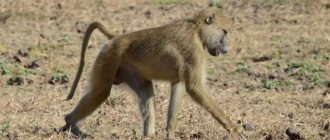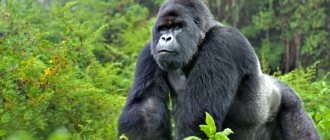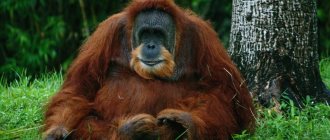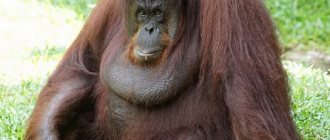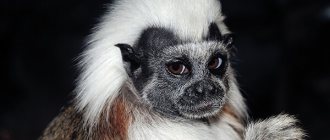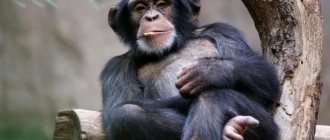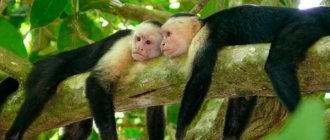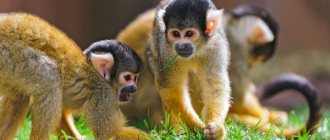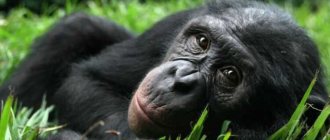- Wild animals
- >>
- Mammals
The baboon is a very common species found in Africa. They are often mentioned in books, we can see them in feature films and cartoons. These monkeys are highly aggressive, but at the same time skillfully get along with people. For their colorful appearance, baboons are nicknamed “dog-faced” monkeys.
Origin of the species and description
Photo: Baboon
Baboons belong to the genus of primates and the monkey family. In the classical classification, there are five subspecies of baboons, but scientists are arguing about the identification of individual species among the categories.
So far the following subspecies have been distinguished:
- Anubis baboon. Great apes from Central Africa;
- hamadryad. They are distinguished by thick hair, a mane and a pronounced scarlet callus;
- Guinea baboon. A little-studied species of baboons, the smallest representative of the species;
- baboon. A small primate capable of interbreeding with many subspecies of baboons;
- bear baboon. The largest baboon, characterized by scanty fur, lives in South Africa.
All representatives of the monkey family have characteristic features by which they can be recognized. These include:
- the so-called “dog head” - an elongated narrow muzzle;
- the presence of large fangs;
- long tail, which is never used for grasping purposes;
- move exclusively on four legs;
- almost all species have pronounced ischial calluses.
The marmoset family differs from other families of monkeys in its aggressiveness not only during the mating season. There have been cases where monkeys from the family attacked tourists, destroyed city stalls, and broke car windows. Their body constitution allows them to move quickly and strike hard, and the size of these monkeys ranges from medium to large.
Scientific classification
- Kingdom: Animalia (animals)
- Phylum: Chordata
- Class: Mammalia (mammals)
- Order: Primates (primates)
- Family: Cercopithecidae (monkeys)
- Genus: Papio (baboons)
- Species: Papio cynocephalus (baboon)
The scientific name of yellow baboons comes from the Greek words "kynos" and "kephalikos", meaning "dog" and "head" respectively. Baboons received the nickname “dog-headed monkeys” because of their characteristic four-legged stance and elongated muzzle , which makes baboons look like dogs. Most other primates, including humans, have flat faces.
Appearance and features
Photo: Black baboon
Males and females differ from each other in size: males are much larger and thicker than females. They often have a thick mane and large muscle mass, as well as long fangs, which females cannot boast of. In many ways, such sexual differences are due to the way of life, where the male plays the role of guarding the harem.
Video: Baboon
The color of baboons varies depending on the subspecies and habitat. It can be dark gray or almost black, brown, brown, beige, silver-gray. You can determine his age by the color of the male, and his social status by his mane. Leading males (there may be several of them if the individuals are young) have a well-groomed, thick mane, which they carefully comb for each other.
Interesting fact: The mane and color of old males are darker than those of young ones; a similar gradation is also noticeable in other representatives of the African fauna - lions.
Baboons are also distinguished by their tail: as a rule, it is shorter than that of other monkeys, since it does not perform any important functions. The first third of the tail, coming from the back, curves and sticks up, while the rest hangs down. A monkey cannot move such a tail; it does not perform a grasping function.
Baboons walk on four legs, but their front legs are developed enough to perform grasping functions. The length of individual baboons varies depending on the subspecies: from 40 to 110 cm. The bear baboon can reach a weight of 30 kg. - Only gorillas are larger than monkeys.
The dog-like face is another distinctive feature of baboons. It has a long, narrow muzzle with close-set eyes, a long nose with upward-pointing nostrils. Baboons have powerful jaws, which makes them serious opponents in combat, and their tough fur protects them from many bites from predators.
The baboon's face is not covered with hair or has a slight fluff acquired with age. The color of the muzzle can be black, brown or pink (almost beige). The ischial callus is brightly colored - usually black, brown or red. In females of some subspecies it swells during the mating season and takes on a rich crimson color.
Varieties
There are three subspecies of baboons:
- common baboon (Papio cynocephalus cynocephalus);
- East African yellow baboon (Papio cynocephalus ibeanus);
- curious baboon (Papio cynocephalus kindae).
Subspecies differences among yellow baboons are small. The young of Papio cynocephalus cynocephalus are born with black fur, which changes to the adult coloration with age, while the young of P. c. kindae have red fur at birth, while members of the subspecies P. c. ibeanus are born white. Young baboons begin to lose their natural coloration from the age of six months, and acquire the coloration of adults by the end of the ninth month.
Photo: Fred Berrington
Another difference between the subspecies is the shape of the tail. "Broken tails" are characteristic of the common baboon; the tail is held almost horizontally from the body, and then drops sharply and appears broken. Other species have more curved tails.
Finally, unlike other subspecies, the East African yellow baboon has wavy rather than straight body hair.
Where does the baboon live?
Photo:: Monkey of the baboon genus
Baboons are heat-loving monkeys, but the habitat itself is not important to them. They can be found in tropical zones, deserts, semi-deserts, savannas, rocky hills and clayey areas. Their omnivorous nature makes them a common species.
Baboons live throughout the African continent, but their range is divided between different species:
- the bear baboon can be found in Angola, South Africa, Kenya;
- baboon and anubis live in the north and equator of Africa;
- Guinean lives in Cameroon, Guinea and Sengal;
- Hamadryas is located in Sudan, Ethiopia, the Aden region of the Arabian Peninsula and the Somali Islands.
Baboons are not afraid of people, and their school lifestyle gives them even more self-confidence. Therefore, flocks of baboons settle on the outskirts of cities or in villages, where they steal food and even attack local residents. Rummaging through garbage and garbage dumps, they become carriers of dangerous diseases.
Interesting fact: In the last century, Cape baboons robbed plantations and killed settlers' livestock.
Baboons usually live on the ground, where they gather and, less often, hunt. Thanks to their clear social structure, they are not afraid of predators, who can easily take out any vulnerable monkeys on earth. If the baboon wants to sleep, he climbs the nearest tree or any other hill, but there are always sentinel baboons who are ready to notify the monkeys of approaching danger.
Baboons do not build nests or create habitable shelters - they simply feed in a certain territory and migrate to a new one if food becomes scarce, water supplies are depleted, or there are too many predators around.
Interesting Facts
- The Anubis baboon is a fairly widespread species that has adapted well to the proximity of people. Families of this species of monkeys often enter plantations and fields and destroy them. For this reason, they also become the target of hunting. In addition, there is a reduction in the natural habitat of anubis, and all together this leads to a gradual reduction in the size of their population.
- The most famous and clearly audible sound that Anubis baboons make is the “bark” when they are alarmed. In addition, a peculiar “roar” or “growl” of the male leader can be heard: if something disturbs the family at night, the male emits a special cry, warning his relatives of the danger, calling on them to unite, and at the same time addressed to the enemy. With quiet, gentle sounds, female Anubis baboon communicate with their cubs, and they, in turn, squeal if they feel any discomfort.
Video
What does a baboon eat?
Photo: Baboon from Cameroon
Baboons are omnivores, although they prefer plant foods. In search of food, one individual is able to travel up to 60 km, in which its camouflage color helps.
Typically, baboons' diet includes:
- fruits;
- soft roots and tubers of plants;
- seeds and green grass;
- fish, shellfish, crustaceans;
- locusts, large larvae and other protein insects;
- small birds;
- rodents;
- small mammals, including ungulates;
- Occasionally, baboons can eat carrion if the flock experiences hunger for a long time, although they do this extremely reluctantly.
Baboons are not shy or timid monkeys. Sometimes they can fight off fresh prey from solitary predators - young lions or jackals. Also, monkeys that have adapted to life in cities successfully raid cars and food stalls, from where they steal food.
Interesting fact: During periods of drought, baboons have learned to dig at the bottom of dry rivers, obtaining drops of moisture to quench their thirst.
Baboons often rummage through garbage, where they also look for food. In South Africa, baboons catch sheep, goats and poultry from the aborigines. Baboons get used to being raiders and, having successfully tried to steal food once, they get used to this activity forever. But baboons are hardy animals, which allows them to remain for a long time without food or even drink.
Now you know what a baboon eats. Let's see how he lives in the wild.
Spreading
Geographic range
Photo: Wikipedia
Yellow baboons are found in central Africa from the western to eastern coasts of Angola, Zambia, Malawi, Mozambique, Tanzania, Kenya and Somalia. Common baboons range from east of the Luangwa River in Zambia to Malawi, northern Mozambique and most of Tanzania. The East African yellow baboon is found in Kenya and southern Somalia and may extend into southeastern Ethiopia, while the curious baboon is found in eastern Angola, southwestern Zambia and parts of southern Democratic Republic of Congo.
- Biogeographic regions : Ethiopian (native)
- Countries: Angola, Democratic Republic of Congo, Ethiopia, Kenya, Malawi, Mozambique, Somalia, Tanzania, Zambia
Habitat
Yellow baboons inhabit thorn scrub, semi-arid savanna, open woodland and gallery forest throughout their home range. Due to the low rainfall on the African continent, monkeys choose habitats close to water sources.
In addition to living in undeveloped savannahs, baboons are highly adaptable and can live alongside people in rural areas that have been developed for agriculture.
- Habitat: tropical
- Terrestrial biomes: forest, thornbush, savanna, grassland, chaparral
Home range
Yellow baboons depend on basic localized resources such as water, food and places to sleep. They determine the nature of their home range, so there are seasonal differences in the size of the day range and personal territory. The predominance of fruits after the rainy season means that the monkeys do not have to travel far to obtain nutrient-rich food, and their daily walks do not exceed 3.4 km. During the dry season, when fruit is scarce, baboons expand their territories, moving approximately 7.2 km daily.
Features of character and lifestyle
Photo: Baboons
Baboons are slow-moving animals that lead a terrestrial lifestyle. Accordingly, they need a good system of protection from predators, which is provided to them by a rigid hierarchy. A troop of baboons has approximately six males and twice as many females. The leader is the leader - usually an adult baboon. He leads the movements of the flock in search of food, is the main defense of the flock, and is the first to engage in battle with attacking predators.
Interesting fact: Sometimes two or three young males come to overthrow a strong leader male, who then together rule the pack.
Young males below the leader also have their own hierarchy: among them there are superior and inferior ones. Their status gives them an advantage in choosing food, but the higher the status, the more the male must participate in active defense of the pack.
Young males watch around the clock to see if the flock is in any danger. Baboons have more than thirty sound signals that notify about certain events, including alarming ones. If a dangerous predator is discovered, the leader rushes towards him, using his massive jaws and sharp fangs. If the leader fails, other males may come to the rescue.
Young males also participate in defense if the pack is attacked by a group. Then a fight ensues, in which there are often dead - and not always on the side of the monkeys. Baboons fight mercilessly and act in a coordinated manner, which is why many predators simply avoid them.
An important part in the life of baboons is grooming - combing out the fur. It also shows the social status of the animal, because the most “combed” is the leader of the pack. There is also a hierarchy in grooming among females, but it does not in any way affect their social status as a whole: all females are equally protected by males.
Meaning for humans
Baboons are closely related to humans and are therefore good candidates for animal models in biomedical research . They are particularly used in studies of physiology, blood, cardiovascular system, neurology and endocrinology. They are also used as a model for studying organ transplantation, treating alcoholism, epilepsy and high blood pressure. About 6% of biomedical research involving non-human primates involves baboons.
Social structure and reproduction
Photo: Baby baboon
Only the leader of the pack can mate unlimitedly; the rest of the males, for the most part, do not have the right to mate with females at all. This is due to the fact that the leader has the best qualities that help monkeys survive - strength, endurance, aggressiveness. It is these qualities that should be passed on to potential offspring.
An adult male at the age of 9 years starts his own harem of females. Males at 4-6 years old either have one female or do without them at all. But when the male reaches 15 years of age, his harem gradually disintegrates - the females go to younger males.
Interesting fact: Homosexual relationships are not uncommon among baboons. Sometimes two young males overthrow the old leader while in a homosexual relationship.
Baboons do not have a breeding period; females are ready to mate at the age of three. Baboons engage in fights for females, but usually young males recognize the unquestioning right to mate with the leader. He bears a great responsibility, since he does not leave pregnant females and females with cubs alone - he gets them food and regularly communicates with the offspring. Young males who have acquired one female behave in a similar way, but their relationship with her is closer.
Pregnancy lasts about 160 days, the small baboon weighs about 400 g. He clings tightly to the mother’s belly with his paws, and in this position the mother carries him with her. When the baby becomes older and stops feeding on milk, he can follow his mother - this happens at the age of 6 months.
Fun fact: Baboons have a feature that is common among pygmy chimpanzees. If a conflict arises within the pack, sometimes the aggression hormone turns into the production of sexual arousal hormones, and instead of fighting, the baboons engage in sexual intercourse.
At 4 months, a transitional age begins - the baboon’s fur brightens, becomes thicker, and acquires a color characteristic of the subspecies. The young animals are united into a group, which also establishes its own hierarchy. At 3-5 years old, males tend to leave the pack as early as possible, while young females prefer to stay with their mothers, occupying their niche in the hierarchy of the pack.
Save Status
Photo: mikeloomis
Yellow baboons are not in danger of extinction , but hunting pressure on them is gradually increasing and could reach unacceptable levels if it is not reduced. Baboons, like other primates, cannot reproduce fast enough to compensate for declining population sizes due to overhunting and changes in the ecosystem.
- Total number: unknown
- Conservation Status: Least Concern
Natural enemies of the baboon
Photo: Crested baboon
Predators prefer to avoid flocks of baboons, but can attack a single female, cubs, or young baboons that leave the flock at the age of five.
Baboons typically face the following enemies:
- packs of lions;
- cheetahs;
- leopards are the most important enemies of baboons, since they skillfully hide in trees;
- hyenas, which even the leaders of the baboons are wary of;
- jackals, red wolves;
- crocodiles;
- Sometimes baboons come across a black mamba, which kills them with poison in self-defense.
Predators do not threaten the baboon population because they can fight off anyone. Rushing at the enemy in a large group, they scream and slam their paws on the ground, producing a shocking effect on the threat. Females usually do not need self-defense, since they are protected by males.
An adult male, as a rule, is able to cope with almost any threat himself. Often a baboon can be seen in a fight with a leopard, from which the predator usually emerges as a loser - he quickly leaves the scene of the battle, sometimes acquiring serious wounds from the sharp fangs of the monkey.
Lifestyle
Yellow baboons walk on all fours, with their tails slightly raised. They spend most of the day on the ground, and at night they take refuge in trees in nearby river or gallery forests. Due to its large size, the group arranges sleeping areas in several trees. They sleep tightly hugging each other . The group leaves the sleeping area every morning from 7 to 10 o'clock.
Once out of the trees, baboons either remain in the immediate vicinity of the grove, socializing and grooming, or move to open pastures to forage. Yellow baboons feed throughout the day, but there are peaks of social activity from mid-morning to mid-afternoon and evening.
One of the reasons baboons seek shelter in trees is for protection from nocturnal predators. Potential predators include lions, cheetahs, leopards, spotted hyenas, jackals, pythons, chimpanzees, servals, lynx, wild dogs and humans.
